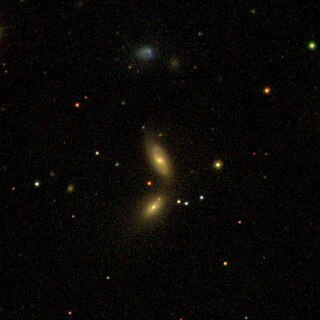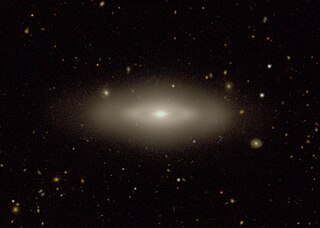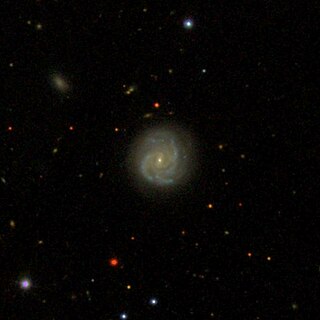
NGC 3 is a lenticular galaxy with the morphological type of S0, located in the constellation of Pisces. Other sources classify NGC 3 as a barred spiral galaxy as a type of SBa. It was discovered on November 29, 1864, by Albert Marth.

NGC 47 is a barred spiral galaxy in the constellation Cetus, discovered in 1886 by Ernst Wilhelm Leberecht Tempel. Its alternate name NGC 58 is due to the observation by Lewis Swift, who was unaware that Tempel had already discovered the celestial object earlier. It appears as a small, faint spiral nebula with a bright core and is slightly oval.

NGC 15 is a spiral galaxy located in the Pegasus constellation. It was discovered by Albert Marth on October 30, 1864.

NGC 38 is a spiral galaxy in the constellation Pisces. It was discovered on 30 September 1867 by Édouard Stephan.

NGC 49 is a lenticular galaxy in the Andromeda constellation. The galaxy was discovered by the American astronomer Lewis A. Swift on September 7, 1885.

NGC 1433 is a barred spiral galaxy with a double ring structure located in the constellation of Horologium. It was discovered by James Dunlop on 28 September 1826, and lies a distance of 46 million light-years from Earth.

NGC 84 is a star in the Andromeda constellation. It was recorded on November 14, 1884 by Guillaume Bigourdan. It is situated close to the Celestial equator, making it at least partly visible in the sky, from both hemispheres in certain times of the year. It is usually mistaken with PGC 1384.

NGC 91 is a star with an apparent magnitude of 14.4 in the constellation of Andromeda. The star is southwest of the galaxy NGC 90. Discovered in 1866 by Herman Schultz, there have been many arguments if this star exists or not. However, people have observed the star, and have confirmed that NGC 91 exists.

NGC 94 is a lenticular galaxy in the constellation Andromeda. It was discovered by Guillaume Bigourdan in 1884. This object is extremely faint and small. A little above the galaxy is NGC 96. NGC 94 is about 260 million light-years away and 50,000 light-years across.

NGC 148 is a lenticular galaxy located in the constellation Sculptor. It is about 40,000 light years across. It is in a group of three galaxies along with MCG-5-2-16 and IC 1555. It is a Shapley-Ames galaxy.

NGC 806 is a spiral galaxy approximately 166 million light-years away from Earth in the constellation Cetus. It was discovered by American astronomer Lewis A. Swift on November 1, 1886 with the 16" refractor at Warner Observatory.

NGC 6040 is a spiral galaxy located about 550 million light-years away in the constellation Hercules. NGC 6040 was discovered by astronomer Édouard Stephan on June 27, 1870. NGC 6040 is interacting with the lenticular galaxy PGC 56942. As a result of this interaction, NGC 6040's southern spiral arm has been warped in the direction toward PGC 56942. NGC 6040 and PGC 56942 are both members of the Hercules Cluster.

NGC 5468 is an intermediate spiral galaxy located in the constellation Virgo. It is located at a distance of about 140 million light-years from Earth, which, given its apparent dimensions, means that NGC 5468 is about 110,000 light-years across. It was discovered by William Herschel on March 5, 1785.

NGC 779 is a spiral galaxy seen edge-on, located in the constellation Cetus. It is located at a distance of circa 60 million light years from Earth, which, given its apparent dimensions, means that NGC 779 is about 70,000 light years across. It was discovered by William Herschel on September 10, 1785.

NGC 1549 is an elliptical galaxy located in the constellation Dorado. It is located at a distance of about 50 million light years from Earth, which, given its apparent dimensions, means that NGC 1549 is about 75,000 light years across. NGC 1549 was discovered by John Herschel on 6 December 1835 and may have been observed by James Dunlop in 1826. It is a member of the Dorado Group.

NGC 4746 is an edge-on spiral galaxy located 107 million light-years away in the constellation Virgo. It was discovered by John Herschel during a sky-survey on March 29, 1830.

NGC 3175 is a spiral galaxy located in the far eastern part of the southern constellation of Antlia at an approximate distance of 54 million light-years. NGC 3175 was discovered on March 30, 1835 by English astronomer John Herschel, whose notes described it as, "considerably bright, large, much extended NE-SW, very gradually little brighter middle". This galaxy is the namesake of the NGC 3175 group of galaxies, which includes the spiral galaxy NGC 3137.

NGC 3009 is a lenticular galaxy in the constellation of Ursa Major. It is about 35 thousand light years across, and with a recessional velocity of 4,445 kilometers per second, is at a distance of 205 million light years from the sun. NGC 3009 is also known by the catalog name of PGC 28330, and is often mistaken for the dimmer PGC 28303. This is because these objects are very close to each other in the sky, and the astronomer Dreyer misinterpreted John Herschel's original March 17, 1828 record of the galaxy, mistaking it for one a few arcminutes to the west. Herschel would have been unable to see PGC 28303 as anything but a background star, due to his less advanced telescope at the time.

NGC 7585 is a lenticular galaxy with a peculiar shape resulting from an interaction between two galaxies. It is located 145 million light years away in the constellation Aquarius which, given its apparent dimensions, means that NGC 7585 is about 100,000 light years across. It was discovered by William Herschel on September 20, 1784.

NGC 2293 is a lenticular galaxy located in the constellation Canis Major. It is located at a distance of circa 100 million light years from Earth, which, given its apparent dimensions, means that NGC 2293 is about 160,000 light years across. It was discovered by John Herschel on January 20, 1835. NGC 2293 forms a pair with NGC 2292 and has an HI ring that surrounds both galaxies.




















